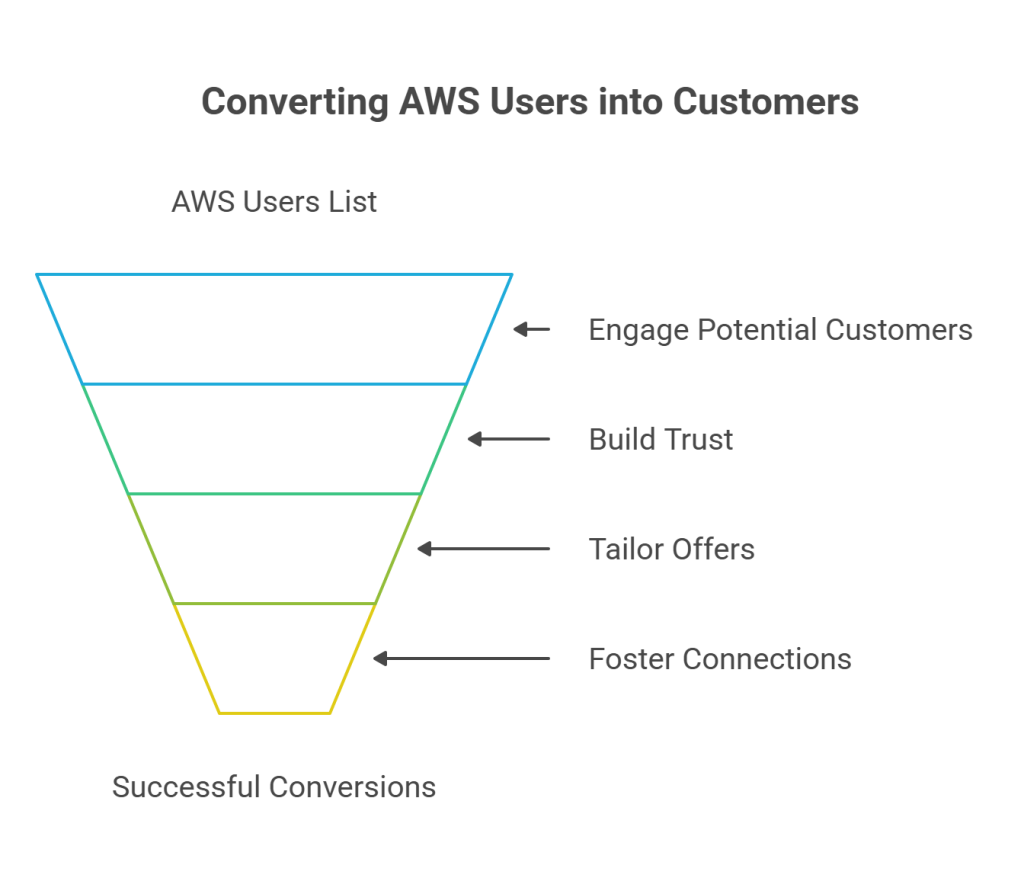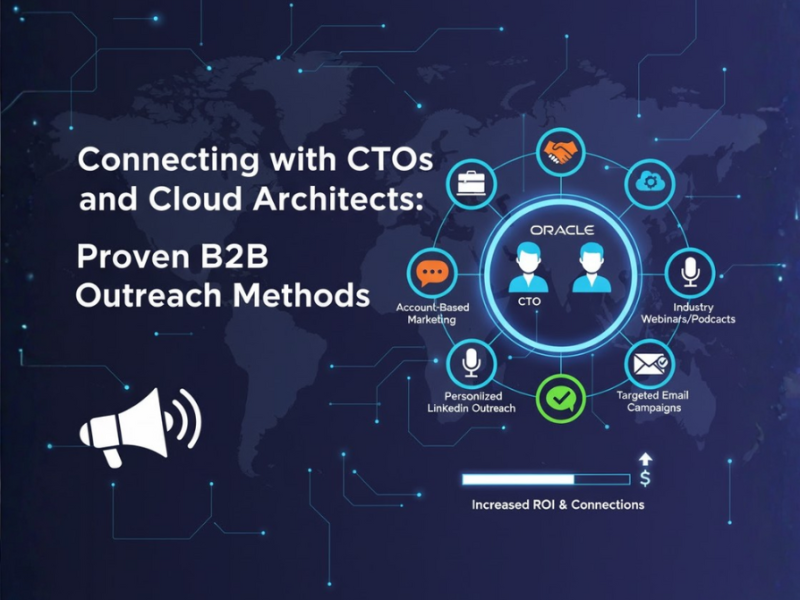With millions of active customers and a dominant share of the cloud computing market, your list of Amazon Web Services (AWS) users isn’t just a list; it’s a goldmine of potential revenue. But are you equipped with the right tools to start digging?
Targeting this audience requires more than a standard marketing playbook. These are technically savvy professionals who value substance over style and can spot a generic sales pitch from a mile away.
Traditional, one-size-fits-all marketing tactics are destined to fail with this knowledgeable and value-driven group. They are resistant to aggressive sales language and instead seek partners who understand their challenges and can contribute to their success within the AWS ecosystem. To achieve successful AWS lead conversion, you must shift your focus from selling to helping.

This article provides eight actionable, trust-building strategies designed to help you cut through the noise. By implementing these approaches, you can effectively engage your AWS user list, build genuine credibility, and convert high-quality leads into loyal, long-term customers.
Segment and Understand Your List
The first step in any effective campaign is knowing your audience. For an AWS users list, this goes far beyond basic demographics. To truly connect, you must segment your list based on the technical realities of their cloud environment.
- Beyond Basic Demographics: Don’t just segment by company size or industry. Group your leads by the specific AWS services they likely use. For instance, a company with a data-intensive application is likely using Amazon S3 Users List for object storage and Amazon RDS for managed databases. A business running large-scale applications probably relies on Amazon EC2 for compute power. This level of segmentation is the foundation for genuine personalization for tech audiences.
- Identifying Pain Points: Once segmented, you can research and infer the common challenges associated with each service. A heavy user of AWS Lambda, for example, might be concerned with monitoring serverless functions or managing cold starts. This insight creates a perfect opening for a solution that addresses these specific AWS user pain points.
- Data-Driven Impact: The effort pays off. Research consistently shows that segmented campaigns can significantly boost engagement. According to Mailchimp, segmented email campaigns result in nearly 15% higher open rates and a staggering 100% more clicks than non-segmented campaigns. This data underscores the power of relevant messaging.
Lead with Value-Driven Content, Not a Sales Pitch
When marketing to AWS users, trust is your most valuable currency. The fastest way to destroy that trust is to lead with a hard sell. Instead, adopt a “help, don’t sell” approach by offering genuine value upfront. This is a cornerstone of effective technical lead nurturing.
- Content That Resonates: Your content should be created by experts for experts. Focus on formats that allow for deep, practical insights:
- In-depth Tutorials: Create detailed, step-by-step guides that solve a specific, nagging problem.
- Technical Whitepapers: Offer deep dives into complex topics, backed by research and data.
- Open-Source Tools: Provide a useful script, template, or small tool that simplifies a common task on AWS.
A powerful example would be creating and promoting a guide titled, “5 Ways to Optimize Your EC2 Instance Costs.” By offering this valuable resource for free, you position your brand as a helpful expert, not just another vendor.
Personalize Your Outreach at Scale
With your list properly segmented, you can now craft messages that resonate on a personal level. The goal is to show your leads that you’ve done your homework and understand their specific context.
- Referencing Their Environment: Use your segmented data to personalize email campaigns and outreach. Your messaging should acknowledge their likely use of AWS and clearly articulate how your solution integrates to make their lives easier.
- Dynamic Content: Leverage marketing automation platforms to insert dynamic content blocks based on a lead’s segment. This ensures that each recipient sees the most relevant information without requiring you to create dozens of separate emails.
An effective, personalized email could begin with a line like, “As a user of Amazon RDS, we know that managing database performance and security can be complex. Our tool simplifies this by providing automated monitoring and alerting, directly within your existing AWS workflow.”
Build Credibility with Social Proof and Case Studies
Technical audiences, particularly developers, are inherently skeptical of marketing claims. They trust the validation of their peers far more than your copy. This is where social proof becomes one of your most potent B2B lead conversion strategies.
- The Power of Peer Validation: Showcase logos of well-known companies in the tech space that use your product. Use testimonials that speak to specific technical benefits.
- Crafting Compelling Case Studies: A well-crafted case study for AWS solutions is invaluable. Structure it clearly:
- Problem: Detail the specific technical challenge the customer faced in their AWS environment.
- Solution: Explain how your product was implemented and how it integrated seamlessly with their existing AWS services.
- Results: Quantify the outcome with hard numbers – e.g., “reduced latency by 30%,” “cut cloud spend by 15%,” or “decreased incident response time by 50%.”
The data backs this up: a B2B marketing report found that 78% of buyers used case studies when researching purchases in the past year, highlighting their critical role in the decision-making process.
Offer a Frictionless Trial or Demo Experience
Developers Lists and IT professionals want to get their hands dirty. They need to test a solution within their own environment before they can champion its adoption. A “try before you buy” model is non-negotiable.
- Seamless Integration: Your trial or demo should be incredibly easy to set up. Complicated installation processes create friction and lead to abandonment. The gold standard is to have your solution available on the AWS Marketplace, allowing for one-click deployment into a user’s existing account.
- Clear Guidance: Accompany your trial with clear, concise documentation and perhaps a short video tutorial to ensure the user can experience the “aha!” moment of your product’s value as quickly as possible.
Leverage Webinars and Technical Workshops
Webinars are a powerful tool for engagement, but they must be positioned as educational workshops, not thinly veiled sales presentations. The goal is interactive learning that addresses real-world problems.
- Choosing the Right Topics: Mine your segment data for relevant topics. If you’ve identified a group of leads using Amazon S3, host a webinar on “Advanced Security Best Practices for Your S3 Buckets.” This targeted approach ensures a high-value experience for attendees.
- Q&A is Key: The most valuable part of a technical webinar is often the live Q&A session. It’s your opportunity to interact directly with leads, address their specific concerns, and demonstrate your team’s expertise, which is crucial for building trust with developers.
Develop a Multi-Touch Nurturing Sequence
Converting a technical lead is a marathon, not a sprint. A single touchpoint is rarely enough. You need a strategic, multi-touch nurturing sequence that guides leads through the buyer’s journey without being pushy.
- The Nurturing Flow: Design a sequence that builds momentum over time. A lead who downloads a top-of-funnel asset isn’t ready for a demo request. Instead, nurture AWS leads with a logical progression of content.
- Sample Sequence:
- Touch 1: Deliver the initial high-value content piece (e.g., whitepaper).
- Touch 2 (3-5 days later): Invite them to a related, deeper-dive webinar.
- Touch 3 (1 week later): Send a relevant case study showing how a similar company solved their problem.
- Touch 4 (after engagement with prior touches): Finally, offer a personalized demo or free trial.
Read More: 10 Steps to Build Your Ideal Customer Profile
Implement Clear and Compelling Calls to Action (CTAs)
Every piece of content and every email you send must guide the user on what to do next. Your CTAs should be clear, specific, and matched to the lead’s stage in the funnel.
- Action-Oriented Language: Avoid the passive “Learn More.” Use strong, action-oriented verbs that promise a specific outcome.
- Match the CTA to the Funnel Stage:
- Top of Funnel (Awareness): “Download the Guide,” “Watch the Tutorial.”
- Middle of Funnel (Consideration): “Register for the Webinar,” “View the Case Study.”
- Bottom of Funnel (Decision): “Start Your Free Trial,” “Request a Personalized Demo.” This ensures your effective CTAs for B2B tech are always relevant and helpful.
Final Thoughts
Your Amazon Web Services users list is more than just data; it’s a community of sophisticated builders and problem-solvers. To successfully convert leads from an AWS users list, you must engage them on their terms.
This means shifting from a sales-first mindset to one rooted in understanding their environment, building trust through expertise, providing tangible value, and positioning yourself as a helpful partner.
By segmenting your audience, leading with high-quality content, personalizing your outreach, and guiding them with a patient, multi-touch approach, you can transform your list from a collection of contacts into a powerful engine for revenue and growth.


